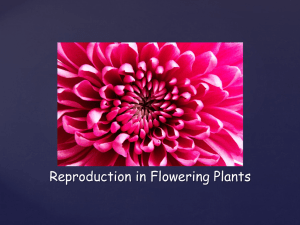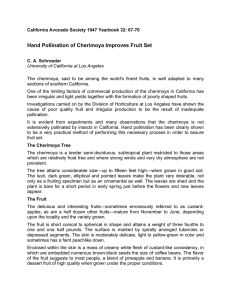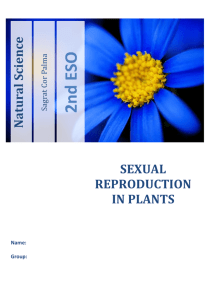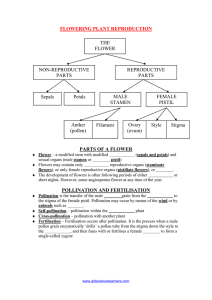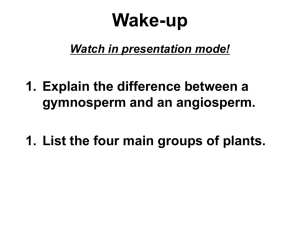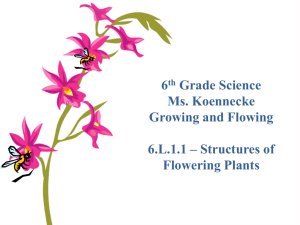POLLINATION OF CHERIMOYA
advertisement
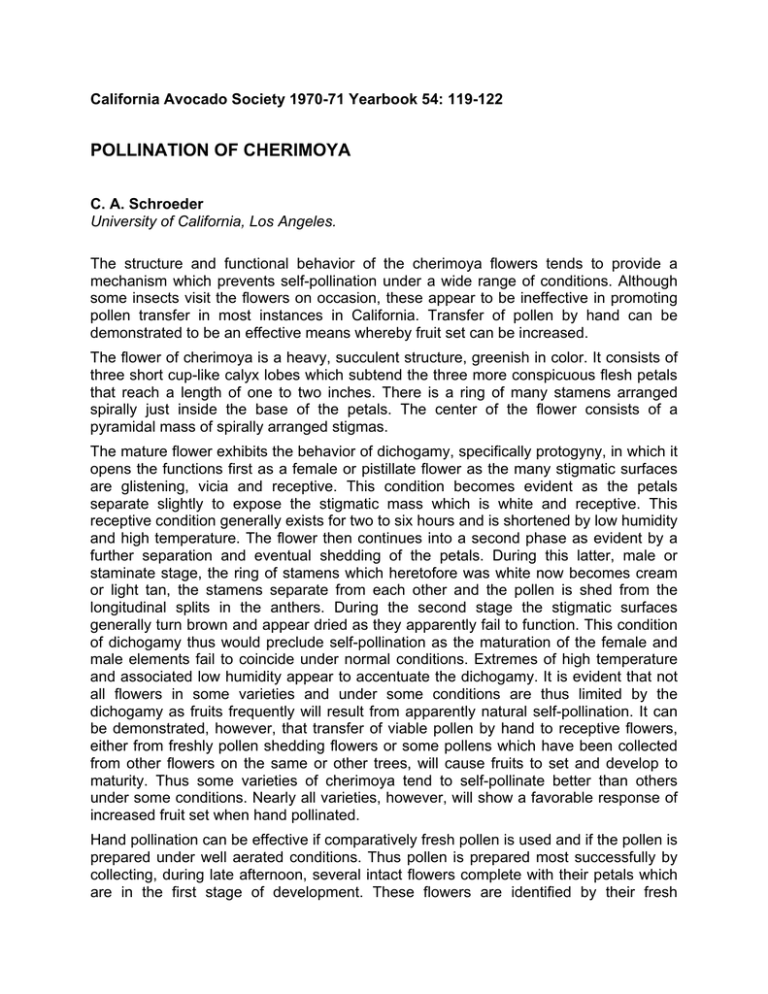
California Avocado Society 1970-71 Yearbook 54: 119-122 POLLINATION OF CHERIMOYA C. A. Schroeder University of California, Los Angeles. The structure and functional behavior of the cherimoya flowers tends to provide a mechanism which prevents self-pollination under a wide range of conditions. Although some insects visit the flowers on occasion, these appear to be ineffective in promoting pollen transfer in most instances in California. Transfer of pollen by hand can be demonstrated to be an effective means whereby fruit set can be increased. The flower of cherimoya is a heavy, succulent structure, greenish in color. It consists of three short cup-like calyx lobes which subtend the three more conspicuous flesh petals that reach a length of one to two inches. There is a ring of many stamens arranged spirally just inside the base of the petals. The center of the flower consists of a pyramidal mass of spirally arranged stigmas. The mature flower exhibits the behavior of dichogamy, specifically protogyny, in which it opens the functions first as a female or pistillate flower as the many stigmatic surfaces are glistening, vicia and receptive. This condition becomes evident as the petals separate slightly to expose the stigmatic mass which is white and receptive. This receptive condition generally exists for two to six hours and is shortened by low humidity and high temperature. The flower then continues into a second phase as evident by a further separation and eventual shedding of the petals. During this latter, male or staminate stage, the ring of stamens which heretofore was white now becomes cream or light tan, the stamens separate from each other and the pollen is shed from the longitudinal splits in the anthers. During the second stage the stigmatic surfaces generally turn brown and appear dried as they apparently fail to function. This condition of dichogamy thus would preclude self-pollination as the maturation of the female and male elements fail to coincide under normal conditions. Extremes of high temperature and associated low humidity appear to accentuate the dichogamy. It is evident that not all flowers in some varieties and under some conditions are thus limited by the dichogamy as fruits frequently will result from apparently natural self-pollination. It can be demonstrated, however, that transfer of viable pollen by hand to receptive flowers, either from freshly pollen shedding flowers or some pollens which have been collected from other flowers on the same or other trees, will cause fruits to set and develop to maturity. Thus some varieties of cherimoya tend to self-pollinate better than others under some conditions. Nearly all varieties, however, will show a favorable response of increased fruit set when hand pollinated. Hand pollination can be effective if comparatively fresh pollen is used and if the pollen is prepared under well aerated conditions. Thus pollen is prepared most successfully by collecting, during late afternoon, several intact flowers complete with their petals which are in the first stage of development. These flowers are identified by their fresh condition, and the initiation of separation of the petals at the lips, the glistening stigmatic surface and the ring of white, tightly packed stamens. The freshly collected flowers are placed on a clean piece of dark colored paper to provide contrast for the small light colored stamens which will be shed. The flowers are covered with slightly moistened paper towels and held overnight. Next morning the petals will be relaxed or shed, the stamens will be cream colored and the pollen shedding. The petals and other flower parts are carefully separated and shaken free of the stamens and pollen. The latter is then poured or brushed carefully into a small, clean, wide-mouth, short bottle and stoppered with a wad of moistened paper toweling to reduce desiccation of the pollen. The pollen, together with any fragments of the stamens, is then taken to the tree and applied to freshly opened flowers which are in the receptive stage. Pollen is transferred with a small soft-haired brush. The brush handle is twisted between the fingers such that the hairs pick up a mass of pollen from the bottle. The fleshy petals of the receptive flower are separated slightly with the fingers and the pollen end of the brush inserted and twisted to cover the receptive stigmatic mass. The operation is facilitated by holding the pollen-vial by a string about the operator's neck or in his pocket, thus allowing both hands to be free to effect the pollen transfer. The results of hand pollination demonstrated in California are first generally to increase the number of fruits which set and develop and second to increase the size and quality, namely the symmetry of the fruit. Frequently those fruits which set naturally without hand pollination are small in size and irregular in form whereas hand pollinated fruits are usually large and symmetrical. The structure of the cherimoya fruit which is called a syncarpium consists of many segments which eventually become fused together as the fruit develops. Development of fleshy tissue only occurs around each seed, hence the more seeds which set, the more fleshy tissue, hence the larger the fruit size or weight. Seedless cherimoya fruit have been reported but are not widely known. The use of plant hormones to induce parthenocarpic or seedless fruit has been tried in the cherimoya, but practical application of these materials remains to be developed. Hand pollination to induce fruit set in cherimoya in California has been demonstrated on many occasions. This still appears to be the most effective manner to insure fruit set in those areas where natural set fails entirely or is low in quantity. A recent typical experiment conducted in August 1970 on the 50 year old orchard of cherimoya trees at the Will Rogers State Park and at the University of California, Los Angeles indicates the effective response of hand pollination above that of natural pollination. Considerable variation in results from hand pollination might be expected due to difference in variety, weather conditions, especially temperature and humidity at time of pollination, general nutritional condition of tree and care in preparation of the pollen. Frequently, 100 per cent fruit set can be induced with hand pollination. Less fruit set is sometimes obtained under unfavorable conditions. The data given above is the result of pollination done comparatively late in the season for the given trees. Pollination done at full bloom appears most effective. Pollination made too early in the bloom season, before fully developed leaves are present on the tree, is generally less effective. Care must be taken to prepare fresh pollen and to prevent its desiccation which can reduce germinability and fruit set. Pollen kept more than one day generally loses its viability. Fruits of cherimoya may average from ½ to 2 pounds or more in weight. These mature under California conditions from five to eight months following pollination. Fruits which ripen in the warmer spring months generally have better flavor compared with those which mature in the cool winter season.
